Traditional technique of making airag in khokhuur and its associated customs
“TRADITIONAL TECHNIQUE OF MAKING AIRAG IN KHOKHUUR AND ITS ASSOCIATED CUSTOMS”
DESCRIPTION
Airag (mare’s fermented milk), is the one of the national pride of Mongolians, especially the nomadic herders, who are the main bearers and practitioners of this ICH element. Airag -mildly alcoholic white beverage is the unique drink derived from traditional technique and knowledge that inherited from ancient time to the different ethic groups of Mongol nation and being used and served as a main and holy drink during various fests and in making offerings and ritual blessings.
It could be considered that the entire Mongolian nation is concerned with this tradition but main bearers and practitioners of this element now are Khalkha Mongol herders who mostly live in the central part of Mongolia. These nomadic people are the true custodians of the traditional knowledge and skills regarding the unique technique of making fermented mare’s milk - Airag in Khokhuur (cowhide vessel or bag) and also making the khokhuur. Those families who bear the traditional knowledge and skills of khokhuur making also concern with this group of people. A variety of socio-cultural entities such as local communities and co-operations of herders, airag makers, horse trainers, associations of long song singers, Morin khuur (horse-head fiddle) players, schools and others also are involved in and support airag making and transmit this national tradition.
Mongolians make the Airag in summer and autumn seasons. Airag is being one of the main food product of Mongolians in summer time, and besides this it is being used as treatment product. Foaming tasty airag has a unique dietetic value and is an important part of daily diet of Mongolians. It is nutritious and easily digestible beverage which contains different proteins, fat, minerals, A, C and some B vitamins and a sufficient amount of amino acids essential for human body. In addition, scientific studies reveal that it is very effective for curing various diseases such as tuberculosis, neurosis, anemia, arteriosclerosis and the decrease of gastric acid secretion and etc. Therefore, this medical beverage is today included in the menus of the numerous health resorts of the country. The first Airag treatment hospitals and nursing places were opened in Mongolian in 1946.
Mare’s airag is a symbol of happiness because Mongolians consider the white color as sacred. Mare’s airag plays an essential role as symbolic beverage in the everyday life of herders as well as during the various social celebrations. Airag is broadly used in making offerings for sacred mountains and sites, and in airag libation rituals to honor the heaven and earth. There is a nice and famous custom of sharing airag during such social events. This custom boosts a cohesion among members of society and represents an important symbol of national solidarity.
Traditional technique of making Airag in Khokhuur and its associated customs
Mare’s Airag is the fermented beverage from mare’s milk. This ICH element includes a traditional method of making mare’s airag, its related equipment and objects such as khokhuur (cowhide vessel or bag), buluur (churning paddle) and khovoo (kibble), and associated therewith social customs and rituals.
The milking season for horses traditionally runs from mid June to early October. Daily milk yield of mares varies from 3 to 6 liters.
The basic traditional technique of making mare’s airag consists of milking mares and cooling freshly milked milk, and repeatedly churning milk in a khokhuur with starter left inside to assist its fermentation. The liquid must be churned 5000 and more times to make good fermented blend of airag. Mare’s milk undergoes fermentation by lactobacilli and lactic acid streptococci, producing ethanol, lactic acids and carbon dioxide. The airag - mildly alcoholic white beverage emits a delicious smell and its pleasant taste can make your mouth watery.
For making the khokhuur, first, the cowhide is soaked and hide’s filament is removed, then it is dehydrated in the wind and fumigated. In such process, the cowhide turns to a white flexible leather. The khokhuur is made from this white leather and consists of mouth (orifice) neck, corner, body and cords. The buluur is long-handled wooden paddle which is used for churning airag in khokhuur and furnished with bored blade of board at the end. Khokhuur can hold 40 to 100 liters of airag.
Airag is used and served as a main and holy drink during various feasts and in making offerings and ritual blessings.
Mongolians have a strong connection with their horses, and this tradition is observed from the traditional technique of making Airag in khokhuur and its associated customs. Airag is one of the respecting and welcoming expressions to the guests. Therefore, Mongolian people often say as "If there is no horse, it means there is no Airag, and if there is no Airag, it means there is no joy".
Geographical distribution
Airag is most common beverage in Mongolia, and made in territory of Saikhan, Mogod, Bayan-Agt soums of Bulgan province, Khairkhan, Khashaat, Khotont soums of Arkhangai province, Erdenedalai soum of Dundgovi province, Burd, Bayan-Ondor soums of Ovorkhangai province, Bayan-Onjuul soum of Tov province.
The other beverages similar to Airag can be found from Khalimag (Kalmyks same origin with Mongols), and Kazakh, Kyrgyz and Autonomous Bashkir as well.
Viability
According to the A/41th order by the Minister of Culture, Sports and Tourism on February 8th of 2013, total 96 ICH elements were registered on the National Lists, including 80 elements on the National Representative List of ICH, and 16 elements on the National List of Intangible Cultural Heritage in Need of Urgent Safeguarding (the copies of the Minister’s Order and List are appended in the link http://www.monheritage.mn/mn/Intangible/ElementList.aspx ). Traditional technique of Airag - making in khokhuur and its associated customs is enlisted in 3.14 of the “National Representative List of ICH”. Additionally, following ICH elements in relation to “Traditional technique of Airag - making in khokhuur and its associated customs” were registered on the “National Representative List of ICH”.
III. Social Practices, Rituals and Festive Events
Mare milking ceremony,
Foal weanling ceremony,
Foal branding ceremony,
Customs associated with traditional beverages, including mare milk,
Traditional technique of producing skin and hide
Traditional skin and hide craft
Example of activities carried out recently by governmental organizations, NGOs and communities.
UNESCO accredited NGO in Mongolia – Foundation for the protection of cultural and natural heritage implemented several projects in close cooperation with National Center for Cultural Heritage and NGOs and communities associated with Airag making traditions and practices.
Project titled: “Reviving and promoting traditional technique of making Airag in Khokhuur”
In 2014 the Foundation invited the community-based organization “Airag Tour” to cooperate for initiating and implementing very important and urgent Project: “Reviving and promoting traditional technique of making Airag in khokhuur and its associated customs”.
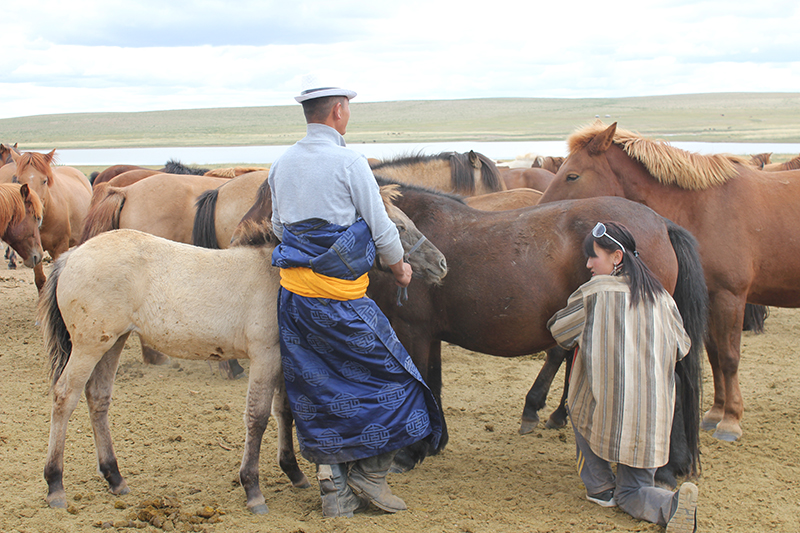
Fig.1-Milking the Mares
This project aimed to revive very important traditional technique of fermenting Airag (fermented mare’s milk) in khokhuur, the cowhide vessel (sack) and also special method of making khokhuur in which traditionally mare’s milk was fermented a to make Airag.
Airag, for Mongolians, is a beverage like wine for the viticulturist as a great care and pride. This intangible cultural heritage includes the traditional method of making Airag, its related equipment and objects such as khokhuur, buluur (churning paddle) and khovoo (kibble), and associated therewith social customs, celebrations, rituals and folk games.
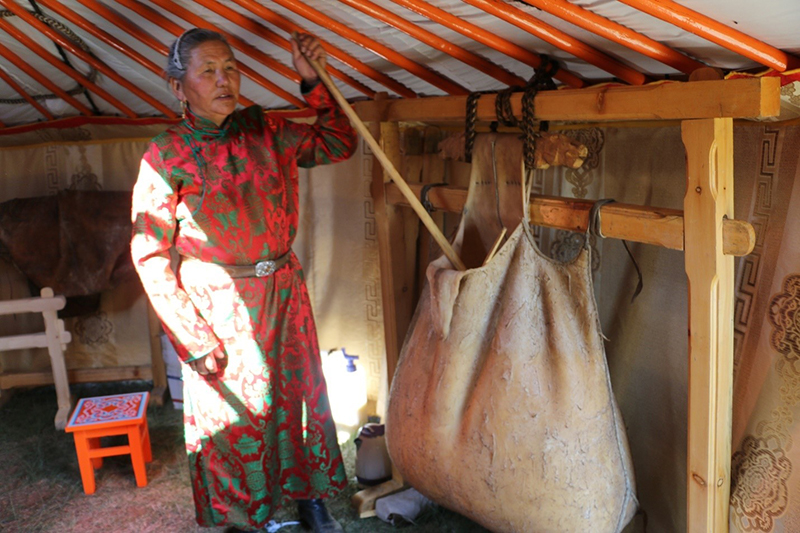
Fig.2-Ms.Gundegmaa churning airag in khokhuur
Mare’s airag fermented in cowhide vessel (khokhuur) as traditionally, has a unique dietetic value. It is nutritious and easily digestible and aromatic white drink. Airag contains different proteins, fat, minerals, A, C and some B vitamins and a sufficient amount of amino acids essential for human body. Airag gives strength and cheerfulness and helps to improve the living body metabolisms. Foaming tasty airag is an important part of daily summer diet of Mongolians.
In addition, airag has scientifically been proven to be of therapeutic benefit. Studies reveal mare’s airag is very effective for curing various diseases such as tuberculosis, neurosis, anemia, arteriosclerosis and the decrease of gastric acid secretion and etc. Therefore, today this medical beverage is included in the menus of the numerous health resorts of the country.
Breathing in the scent of the sparkling Airag and diving into its sensuality people learn something more than just a taste. They are penetrated by nomadic people’s culture, customs and philosophy. Airag is used and served as a main and holy drink during various feasts and in making offerings and ritual blessings. It is broadly used in making offerings for sacred mountains and sites, and in airag libation rituals to honor the heaven and earth. There is an exciting and popular custom of sharing airag during such social events. This custom boost cohesion among members of society and represents an important symbol of solidarity, identity and hospitality.
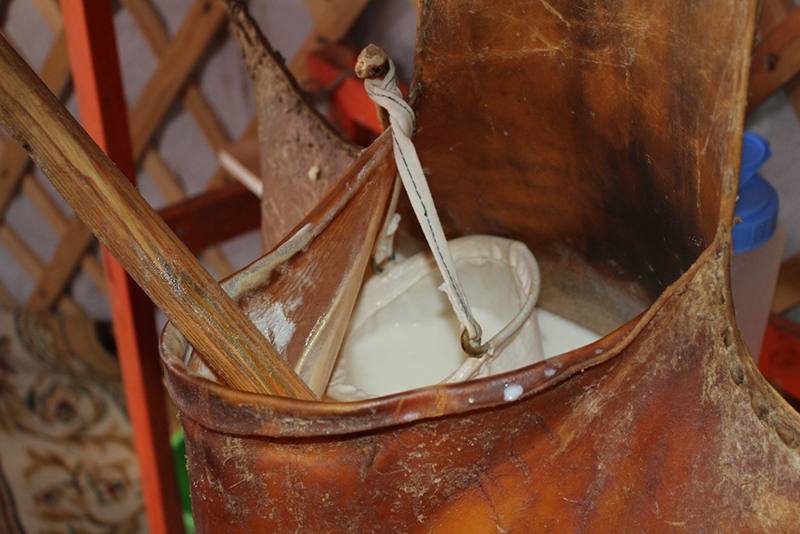
Fig.3-Traditional technique of making Airag in Khokhuur
Unfortunately, during last half century, number of families and practitioners who used the khokhuur for fermenting Airag, has been dramatically decreased and along with this almost has been forgotten the traditional method of making and using the khokhuur even in core areas of Airag. The main reason of this is that for making Airag the people started to massively use a plastic vessel instead of traditional khokhuur. This has resulted in considerably decreasing very specific good quality of Airag and having lost its valuable characteristics and nice taste. Airag fermented in khokhuur always remains fresh compared to the Airag fermented in a plastic vessel.
Such phenomenon adversely affects the quality nutrition and taste of Airag, as well as, consequently decreases main source of cash and barter income of Airag making communities and sustainable subsistent livelihood.
Therefore, it was raised an urgent need to revive and bring back this valuable traditional technique of making khokhuur and fermenting Airag to daily use at least in core areas where live most of Airag making communities.
In framework of the project the Foundation in collaboration with local communities and authorities of such Airag making provinces as Bulgan, Uburkhangai, Arkhangai, Dundgobi, Tuv organized attractive and intensive campaign titled as “Let’s make Best Khokhuur and Tasty Airag” among Airag making families and soums (last administrative unit in Mongolia).
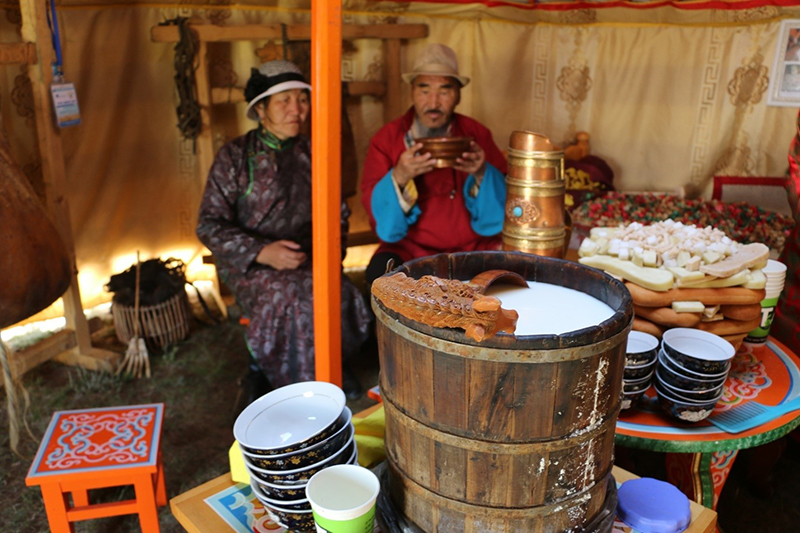
Fig.4-Making Airag in Khokhuur
One of the families which was actively involved in the campaign and participated in the Contest is called Saikhanbileg’s. This family belongs to what was nowadays known as Bayan-Ondor soum, Ovorkhangai province. His wife Gundegmaa is famous in her homeland for her method of making airag in khokhuur, lives in a group of gers with her mother, husband and children, passing on the tradition of making “Unkhan khokhuur” brand of Airag.
Knowledge and skills of making airag and khokhuur are orally and visually passed down from generation to generation through home-practicing by family members. From a tender age, children witness and learn the processes of caring horses, tethering foals, milking mares, churning airag and making a khokhuur from their elders. Since Saikhanbileg’s use khokhuur for three generations they enjoy the best of khokhuur and drink the best of Airag. Their sons wake up early and ride out to round up their horses which spent the night out in the country, they greet the sun rising in the steppe and enjoy the life of a horse herders and meet the new morning of their lives. This simple life, smell of dried cow dung fire, enclosure that smells of livestock has become living witness to this unique culture and inimitable way of life of Mongol herders. Mongols who utilize everything from the animals except their breath, make milk buckets and khokhuur for Airag themselves. Gundegmaa learned these skills helping her parents. Their family was famous for making khokhuur in their homeland and they lined them from the northern side of the Ger along the lattice wall to the entrance and made Airag in them. They still make and use their “Unkhan khokhuur” brand of khokhuur.
The preparation of and making khokhuur is one of the oldest branches of Mongolian traditional handicraft. Venerable Sainbileg and his wife have made five cowhide khokhuur this year. His sons participate in this process each with their own roles. Animal skin becomes the best material for khokhuur. Since the skin breathes itself and with the help of this air exchange airag, and milk inside ferments and always remains fresh. Herders who have used the big cow for their winter food keep the hide, soak it and scrape off the outside hair and prepare to turn it into a white flexible leather.
Many herder’s families such as Sainbileg’s family participated in the Campaign and Contest replacing plastic vessels with cowhide khokhuur and enjoying really tasty and sparkling Airag. Mare’s Airag plays an essential and honorable role during the various ceremonies, rituals and Naadam celebrations. During Naadam celebration days the dignitaries and honorable guests are served with aromatic and best Airag which is made in khokhuur and brought from different families who make famous and tasty Airag. A sparkling Airag is sprinkled down the head of winning swift horses and present cup of Airag to the winning wrestlers and winners-children jockeys.
Therefore, organizers of the Campaign have decided to hold the Show-Festival as a result of Campaign and Contest under title: “Let’s make Best Khokhuur and Tasty Airag” in honor of the Great Danshig Naadam dedicated to the commemoration of the 380th anniversary of Undur Geghen Zanabazar, First Bogdo, First religious Leader and Mongolian Great enlightener. The Danshig Naadam was held on the 25th July 2015 near the ancient Kharakhorum, Capital City of Mongol Empire, in Kharakhorum soum of Uburkhangai province which is famous for its best Airag.
On the eve of Great Danshig Naadam the opening ceremony of the Show-Festival of Airag was held which was well attended by representatives from almost all provinces and soums of Mongolia who came to enjoy the Great Danshig Naadam and Tasty Airag.
In order to participate in the Show-Festival of Airag and the Contest came more than 60 Airag making families from 25 soums of 5 provinces. Each family brought with them their own Ger (Mongolian felt shelter) in which they displayed their cowhide khokhuur with Airag, Airag related equipments and objects with various decorations and meanings. About 60 gers were erected in big circle in the middle of which participants performed odes, benedictions, rituals, practices, dances and games associated with Airag and sung long song with cup of Airag in hands and so on. Approximately 3500 people including foreign tourists and guests watched the Show-festival of Airag and selection process of the Contest. Happy local women accustomed to welcome the guests with cups full of Airag during that day have been taken care that their cups are always filled. Nowadays, such custom of hospitality is broadly used during visits of the foreign guests and tourists to Mongolian families of herders or Naadam festivals for introducing nomadic tradition and lifestyle. In such ways Mongolian Airag greatly contributes to the mutual respect and kind relationships not only among local communities but among different ethnic groups and people of different nations. During the festival special jury judged through the degustation of all Airags brought from families for selecting best Airags. The jury also selected the best khokhuur and Airag related equipments, best expressions and presentations of rituals, ceremonies and other ICH elements associated with Airag.
After this project has implemented, the consumption of Airag femented only in khokhuur has obviously been increasing and many Airag making families have replaced plastic vessels with nice khokhuur and this has been resulting also in increasing of revenues of families from selling good quality Airag.
Additionally, the documentary (30 minutes) titled as “Traditional technique of making Airag in khokhuur” has created under auspices of ICHCAP and the UNESCO accredited NGO in Mongolia - Foundation for Protection of Cultural and Natural Heritage, between 2016 and 2018.
INVOLVEMENT OF COMMUNITIES, PRACTITIONERS AND RELATED NGOS
Within the frame of the registration and inventorying done by the National Center for Cultural Heritage between 2010 and 2016, the center has organized several meetings, seminars, field researches and festivals with practitioners, bearers, local people, and Local Administrations for supporting the nomination file “Traditional technique of making Airag in khokhuur, and its associated customs”.
Consents are able to see here the following links.
1. Consents from Ovorkhangai, Bulgan and Arkhangai provinces.
2. Consents from Dundgovi province and Ulaanbaatar city.
INVOLVEMENT OF COMMUNITIES, BEARERS AND NGOS IN UPDATING PROCESS OF INVENTORY
The preservation of airag-making techniques has been a community-based effort. The all processes of active and free involvements of communities, groups, individual bearers is vividly shown in the documentary film submitted with nomination dossier. The proposed safeguarding measures have been discussed and planned through numerous consultations and will be implemented by community based NGO’s, along with the national and local governments and other stakeholders.
In the future, preservation associations, supported by local municipalities, will continue to play leading roles for the implementation of the proposed safeguarding measures.
Activities such as successor training, holding workshops, exhibitions and other public events, documentation and publication on Airag have been planned and organized by the members of community based NGOs by themselves. These activities have been undertaken with the assistance provided by the national and local governments. Each preservation association will continue their efforts and the national and local governments will further offer various supports for the safeguarding and transmission of the skills required to produce the necessary equipment and tools. Compiling inventories and offering various advice related to the safeguarding and transmission of the traditional techniques for making Airag will be promoted.
Practitioners and bearers of the “Traditional technique of making Airag in Khokhuur and its associated customs” are living in the several soums of Arkhangai, Bayan-Ulgii, Bulgan, Dundgovi, Tov and Ovorkhangai provinces (indicated on the map). These bearers and practitioners who included in this inventory are the masters in making of Airag in khokhuur, and well respected in their living area.
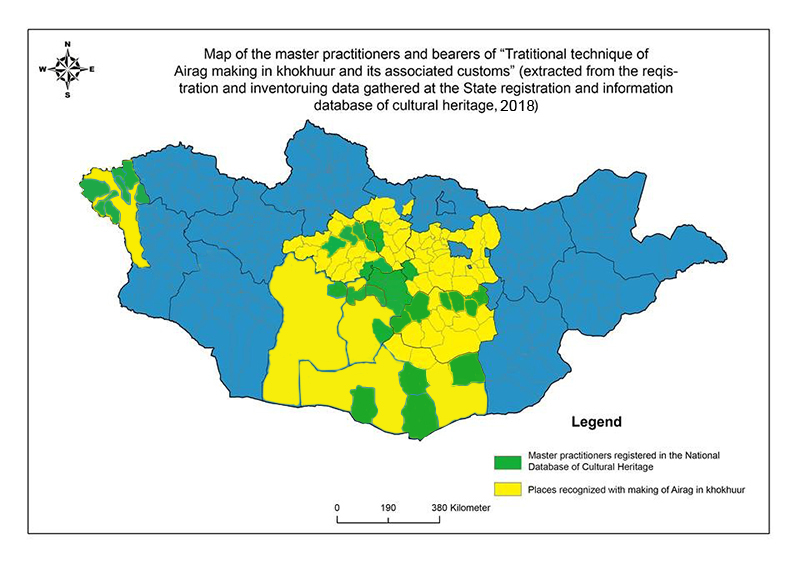
The list of the master practitioners and bearers of Traditional technique of making of Airag in khokhuur and its associated customs.
REGISTRATION OF AIRAG AND KHOKHUUR MAKING PRACTITIONERS
/Between 2010 and 2018/
The traditional technique of making Airag in Khokhuur and making of Khokhuur, both included in the domain “Social practices, rituals and estive events” and “Traditional craftsmanship” of Mongolia. As of 2018, total of 232 practitioners of which 226 are airag making practitioners and 101 are khokhuur making practitioners have been registered in the State Registration and Information Database of Cultural Heritage from the Arkhangai, Ovorkhangai, Dundgovi, Omnogovi, Tov and Bayan-Olgii provinces, which are recognized in Mongolia as places where the Airag was originated. Besides making airag in khokhuur, some of these practitioners are making khokhuur as well.
The result of survey taken on airag and khokhuur making practitioners
№ | Province names | Number of practitioners of making airag | Number of practitioners of making khokhuur | Total practitioners /including both practitioners of making airag and khokhuur/ |
1 | 36 | 22 | 36 | |
2 | 14 | 10 | 14 | |
3 | 32 | 14 | 32 | |
4 | 110 | 29 | 116 | |
5 | 15 | 8 | 15 | |
6 | 19 | 18 | 19 | |
Total | 226 | 101 | 232 |
The information of practitioners and bearers of “Traditional technique of making Airag in khokhuur and its associated customs” have extracted from the data collected from the registration and inventory of ICH elements and its bearers, sent by the initial units of the registration and information database of cultural heritage at soum/ province level to the State registration and information database of cultural heritage, in between 2010 and 2018. According to the Para 20.1, 20.2. 20.3, 20.4 and 20.5 of “Protection Law on Cultural Heritage”, the initial unit of registration and information database of cultural heritage at soum and province level has to send the registration and inventory to the Registration and Infromation State Database of Cultural Heritage.
LIST OF PUBLICATIONS
1. S.Badamkhatan "Airag" in "Traditional food and Beverages" in: "Ethnography of People's Republic of Mongolia", Ulaanbaatar, Mongolia. State Press Agency. 1987. pp 177
.jpg)
.jpg)
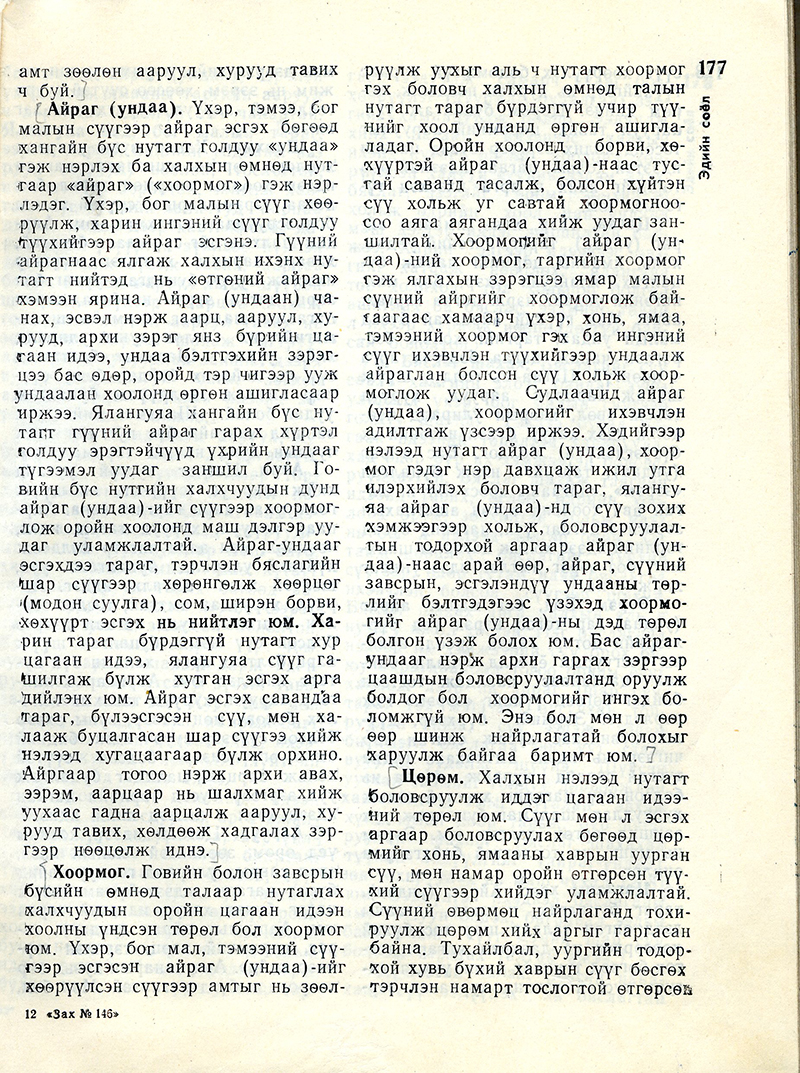
2
2. GONGORJAV Gombojav "Mongolian traditional food and beverages: Airag (mare's fermented milk)" in: URTNASAN Norov, "Intangible Cultural Heritage of the Mongols", Ulaanbaatar, Mongolia, 2010. pp 207.
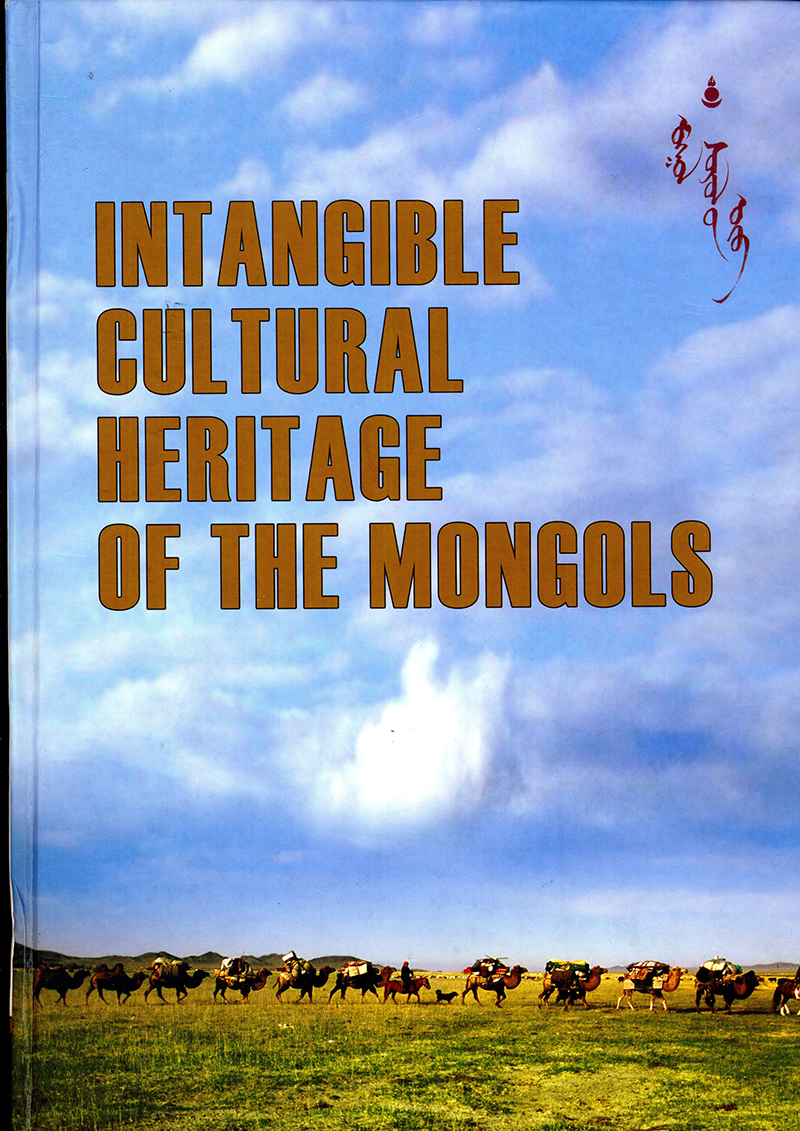

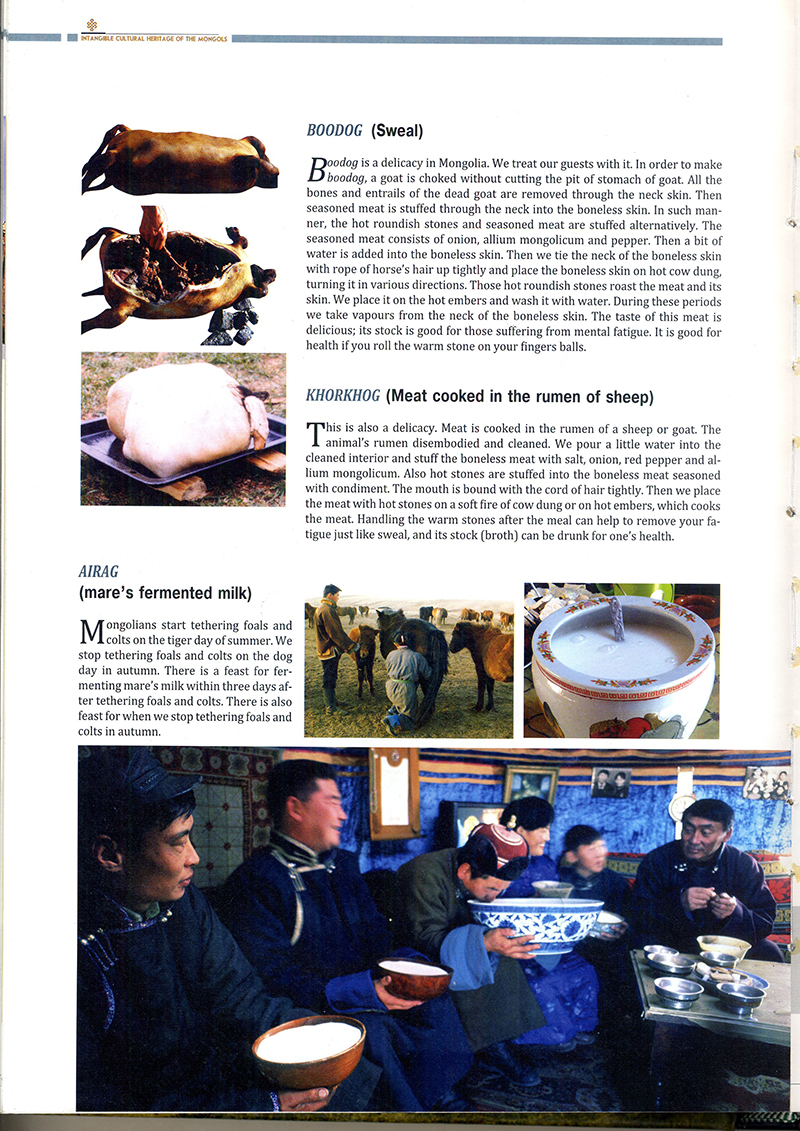
3.
3. S.Yundenbat "Traditional technique of making dairy product" in: "Important Intangible Cultural Heritage of the Mongols", Ulaanbaatar, Mongolia. Monkhiin Useg Press. 2011. pp 36
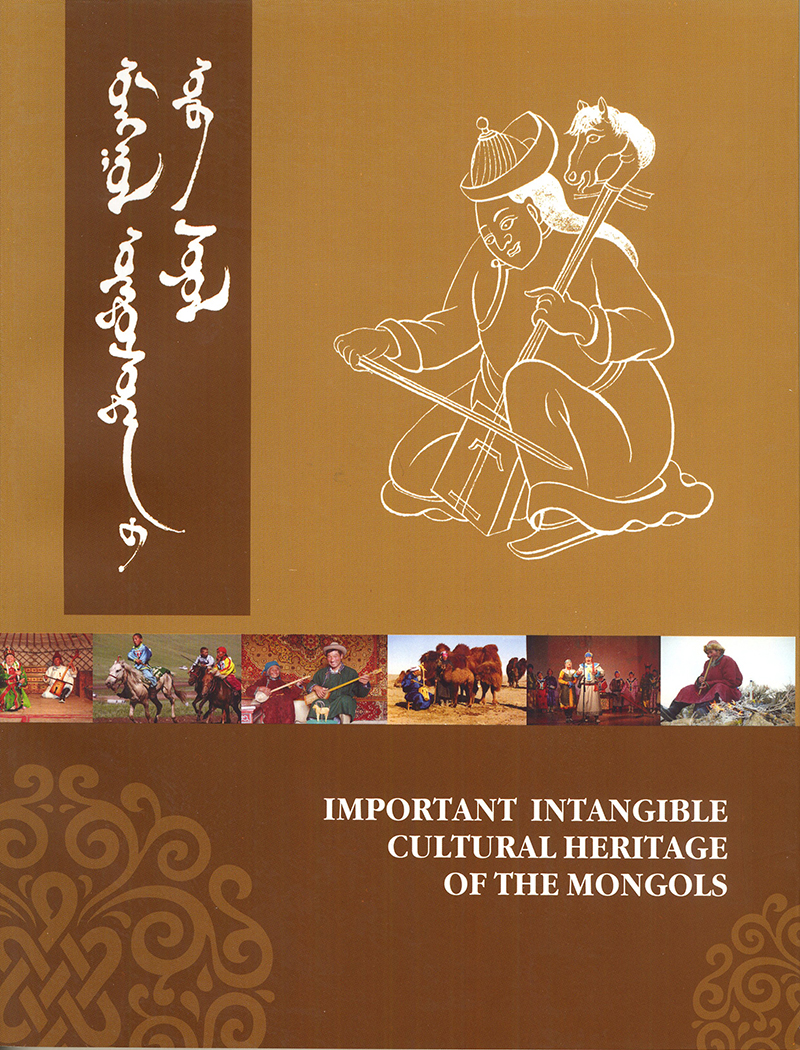
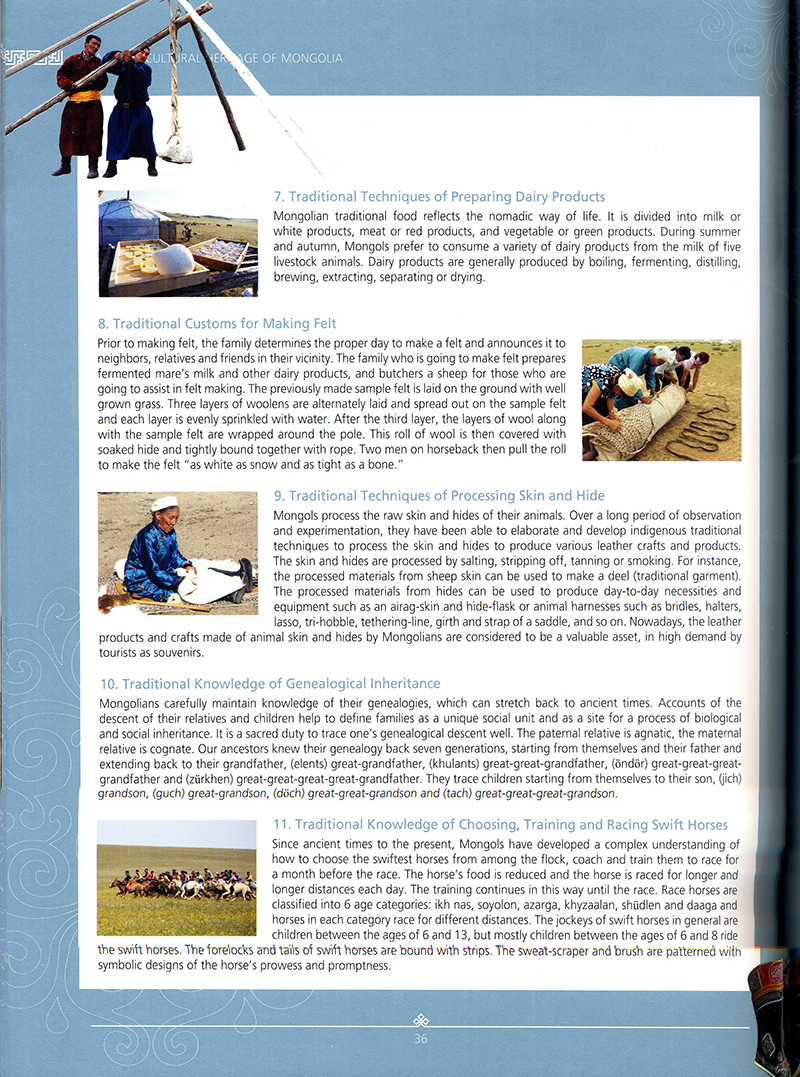
4.
4. D. Tangad "Airag" in: "Traditional food and beverages" in: "Mongolian ethnographical studies" 5th volume, Ulaanbaatar, Mongolia. 2014. Monkhiin Useg Press, pp 13, 14
.jpg)
.jpg)
.jpg)
.jpg)
5.
5. JARGALSAIKHAN Tsamba, "Making of Airag -mare's milk" in: "Reference book of Culture", Ulaanbaatar, Mongolia, 2015. pp 347
.jpg)
.jpg)
.jpg)
6.
6. SARUUL Arslan, NASANJARGAL Jargalsaikhan "Airag and traditional bevarages, its related customs - distribution map" in: ENKHBAT Galbadrakh "Risk Assessment Atlas of Cultural Heritage", Ulaanbaatar, Mongolia, 2017. pp 56.
.jpg)
7.
7. SARUUL Arslan, NASANJARGAL Jargalsaikhan "Airag and traditional bevarages, its related customs - distribution map" in: "Reference book of the Intangible Cultural Heritage", Ulaanbaatar, Mongolia, 2017. pp 116-121.
.jpg)
.jpg)
